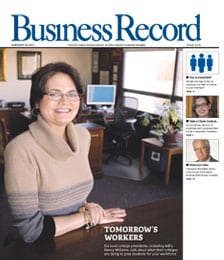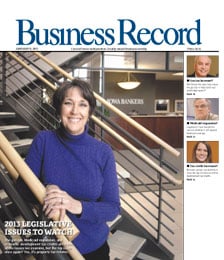Des Moines University’s technology advances learning

Annette Neumann can see herself becoming an osteopathic physician — literally.
As a second-year student at Des Moines University, Neumann practices her exam-room manner about once a month at the university’s Standardized Performance Assessment Lab. Immediately following the 20-minute graded session — or anytime within the following 10 days —she can review a digital recording of it, using the laptop computer each student is issued upon enrollment.
“The video is pretty valuable because you’re able to see little things you shouldn’t do when you’re with a patient, like maybe saying ‘um,’ or touching your face,” said Neumann, who has previously worked in healthcare as a nurse and a chiropractor.
DMU recently upgraded the SPAL facility, which consists of 12 exam rooms equipped with cameras, one-way observation windows and earphones for instructors to listen in, from videotape to digital technology. It’s one of the latest advances by an institution that prides itself on being a leader in technology for its students.
The university, which has more than 800 students training in osteopathic medicine, and about 325 undergraduate students in podiatric, physical therapy and physician assistants programs, adopted the goal of creating “distinctive technology infrastructure and applications for students” as it updated its strategic plan about four years ago.
“We were beginning to recognize at that time that among those students coming here (more than 70 percent from outside the state), there was no digital divide,” said William Appelgate, DMU’s vice president for planning and technology. “If there was any digital divide, it was going to be between those students and their expectations and what the university was doing, because these students coming to Des Moines University are not just bright students; they’re the brightest of the brightest.”
Within a year of that strategic update, the university launched a sophisticated online portal system that serves as a one-stop scheduling and life organizer for students. Then, two years ago, the university began providing each student and faculty member with a laptop computer and handheld device.
“It improves communication when everyone is on the same hardware and software,” Appelgate said. “It makes the whole world more manageable. And it improves our ability to respond to problems for students. The percentage of time our help desk can help someone has gone up from about 60 percent to probably 98 percent.”
Neumann said the interest that administrators demonstrate in meeting students’ needs is impressive.
“For instance, we wanted digital recording of lectures,” she said. “We requested that, and it took them a few months, but they were able to do that. So I think they’re always willing to listen; they care about the student and making it a better learning environment for the student. That’s probably what drew me (to DMU) the most.”
DMU’s technology also includes Blackboard, which allows students to access and review presentations that were made in the classroom from their computers. An added element is the Virtual Microscope program, which enables instructors to digitally map microscope slides for presentations.
To assist its instructors in using these types types of technologies, DMU developed a Teaching-Learning-Technology Center, designed to provide “just-in-time” training for faculty members.
“We have a deep belief that different people use technology at different rates and at different levels,” Appelgate said. “We’ll either teach a faculty member ‘how to fish,’ or we’ll fish for them. It seemed more service oriented if we could provide technology assistance just like you want to do it.”







